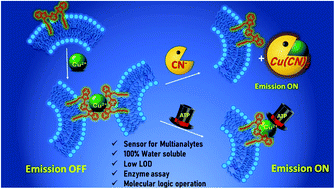Multi analyte sensing of amphiphilic tridentate bis(benzimidazolyl)pyridine incorporated in liposomes and potential application in enzyme assay†
Abstract
A liposome based nanosensor Lipo-1 for efficient detection of copper, cyanide (CN−) and ATP in a pure aqueous medium has been described. Lipo-1 shows a fluorescence ON–OFF response with copper. However, Lipo-1.Cu (Lipo-1 and copper ensemble) was used for the OFF–ON detection of ATP with nM and CN− with μM detection levels, lower than the WHO permissible level for safe drinking. Lipo-1 has better and enhanced binding properties over the counter organic amphiphilic compound Bzimpy-LC, which is not soluble in water. The significant changes in the emission spectra in the presence of Cu2+, CN− and ATP ions, as variable inputs, are used to construct INHIBIT and OR logic operations in a nano-scale environment. The fluorescent detection of CN− ions with Lipo-1.Cu was used to develop an enzyme assay for β-glucosidase using amygdalin as the substrate. β-Glucosidase enzymatic activity was monitored by the emission OFF–ON signal of the probe Lipo-1.Cu by CN− detection. This approach could be an efficient method for developing a fluorescence-based β-glucosidase enzyme assay. A switch ON luminescence response, low detection limit, fast response, 100% aqueous solution, biocompatibility, multi-analyte detection, and improved sensitivity and selectivity of Bzimpy-LC in lipid bilayer membranes are the main features of the nanoprobe Lipo-1. These properties give it a clear advantage for analytical applications.



 Please wait while we load your content...
Please wait while we load your content...